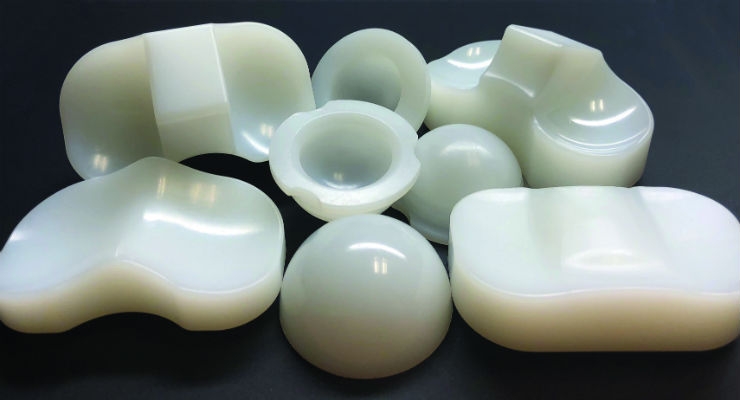Michael Barbella, Managing Editor03.15.18
It was love at first sight.
Or first spark, actually.
Though she was much too young to understand the complexity of juvenile love, Canan Dagdeviren sensed something magical taking place that long ago day in the forested hills of her native Turkey. And it was triggered by the simple act of enkindling—specifically, the ancient art of creating sparks from two rocks.
“I loved the idea that you deform this material and create sparks,” Dagdeviren, now 32, told Waukesha, Wis.-based Discover magazine last summer. “It was very exciting.”
And impactful. The fire-starting lesson, in fact, only confirmed Dagdeviren’s love for materials science, a subject area with which she first became acquainted through the biography of two-time Nobel Prize winner Marie Curie, a pioneer in the study and understanding of radioactivity. A gift from her father, the biography proved inspirational for Dagdeviren, though her muse was actually Pierre (her “scientific love”) rather than Marie. The French physicist and his older brother Jacques introduced the world to piezoelectricity in 1880, naming their discovery after the Greek word “piezein” (to squeeze or press). A series of experiments the brothers conducted proved that certain crystalline materials generate an electrical charge proportional to mechanical stress—much like rubbing two stones together to create a spark.
Aiming to produce her own heat in the scientific community, Dagdeviren studied physics and materials in college, eventually obtaining a doctorate in materials science and engineering from the University of Illinois at Urbana-Champaign. She’s worked in laboratories developing ferroelectric and piezoelectric materials for biocompatible electronic devices, and last year launched a new research group at the Massachusetts Institute of Technology (MIT) to explore materials, device designs, and fabrication strategies for micro- and nanoscale electromechanical systems.
Much like her girlhood infatuation, Dagdeviren is working to leave her own legacy in science through piezoelectric technology. As a Ph.D. student at the University of Illinois, Dagdeviren developed a tiny device capable of being permanently implanted inside the body and harvesting energy from organ movement (e.g., the beating heart, rising diaphragm, expanding/deflating lung). Comprised of zirconate titanate, the animal-tested device generates a small electric charge as it continuously changes shape; although it is small, the steady current is strong enough to power implantables like pacemakers without the need for batteries.
“Every part of our body has a language,” Dagdeviren noted in a Motherboard interview last winter. “With our devices—conformable ones—we’re translating biological language into electric language.”
Dagdeviren is also using her translational technology to measure skin changes too slight for human detection. Inspired by her mother’s frustration with dry skin treatments, Dagdeviren created a small, flexible, stretchable rubber sensor that adheres like a sticker and moves with the skin. Piezoelectric nanoribbons in the device generate small charges capable of measuring hydration levels, moisturization, and skin density. The latter analysis is particularly useful for detecting early-stage skin cancers, as malignant growths typically are slightly thicker than their surroundings. Dagdeviren and her research group currently are exploring other potential applications for the sensor as they await patent approval.
Such approval is becoming far more frequent these days as researchers and materials scientists work to improve medical device quality, reduce costs, and enhance product performance. Their efforts have resulted in such novel advancements as 3D-printed and hybrid polymers, flexible piezoelectric substances (Dagdeviren’s sensor), highly porous titanium, and “superomniphobic” liquid-repelling matter. The development of these newer materials is forcing the industry to re-examine its medical device ingredient list and, in some cases, embrace non-traditional elements. Manufacturers, however, have been slow to welcome alternatives due to conservatism, comfort levels, and a thicket of global materials regulations. As one life sciences expert said: “Most medical manufacturers are conservative people and are used to a small palette of materials that FDA reviewers are comfortable with and have seen before. It’s easier to get along and go along and not challenge the FDA’s comfort level with new materials.”
The U.S. Food and Drug Administration’s (FDA) comfort level historically has been limited to metals, ceramics, and plastics, with stainless steel the odds-on (metal) favorite. Used for decades to construct numerous medical products ranging from tiny screws, catheter reinforcements, and needle cannula to surgical instruments and artificial joints, stainless steel is fancied for its good corrosion resistance, strength, and low cost.
Other prized metals include titanium, tantalum, and nitinol. Titanium’s strength, durability, biocompatibility, corrosion resistance, flexibility, and MRI/CT compatibility has helped propel this alloy to the top of design lists for joint replacements, heart valve housings or support, and surgical instruments. Tantalum, meanwhile, has been a staple of the shaped-wire sector for more than 40 years due to its joinability and sound dielectric properties, while nitinol is popular among stent manufacturers for its superelasticity and biochemical compatibility.
Though metals are still a preferred material for many device applications, the substance has gradually ceded ground and FDA comfort zone share to polymers over the last several decades as technological advancements produced cheaper, safer, more durable alternatives that help reduce hospital-acquired infections. Some of the most popular medical fibers and resins include polyvinyl chloride (PVC), polypropylene, polyethylene, and polystyrene as well as nylon, polyethylene terephthalate (PET), polyimide, polycarbonate (PC), acrylonitrile butadiene, polyether ether ketone (PEEK), and polyurethane. PVC is the most widely used medical plastic, having become a darling of late among pre-sterilized single-use device makers.
PEEK and ultra-high molecular weight polyethylene (UHMWPE) have gained significant ground in the orthopedic and cardiovascular sectors, due largely to their high strength and durability. First used clinically in 1962 by Sir John Charnley, UHMWPE emerged as a dominant bearing material for total hip and knee replacements in the 1970s and remained the substance of choice until the polymer was modified through cross linking (gamma or electron beam radiation) and anti-oxidant additives (Vitamin E).
PEEK, initially conceived as a high temperature-resistant, tough cable insulator, was developed as a biomaterial in the 1980s to meet demand for a strong but flexible biocompatible substance that reduced stress shielding risk. The material was first used in spinal surgeries but has proved its worth in other high-performance areas of medicine as a versatile general-purpose molding and extrusion substance in both natural and reinforced forms. In all formats, PEEK has been used in more than 9 million implanted devices over 19 years spanning trauma (plates, nails, and screws); arthroscopy (anchors and interference screws); orthopedic (finger, hip, and knee) components; cranial plates; spinal; dental implants; cardiovascular; neurological; and bariatrics.
Like UHMWPE, PEEK has been tweaked to enhance its natural properties. The addition of carbon and glass improves the material’s compressive strength and reduces expansion rates. Additionally, carbon fibers boost PEEK’s heat dissipation, thereby allowing the substance to perform more effectively for a longer period of time and augmenting its electrostatic discharge properties. Carbon fiber-reinforced (CFR) PEEK also boasts a more effective wear resistance and load-carrying capability: Clinical data shows CFR-PEEK proximal humerus locking plates provide comparable or superior locking screw fixation strength compared with traditional stainless steel locking plates, and the CFR plates can tolerate at least an equivalent, and in some sections of the plate, a significantly greater load before failure when compared with their stainless steel (locking proximal humerus) counterparts.
“Cross-linking and Vitamin E have been major innovative changes for UHMWPE, and enhancements to PEEK for improved performance, are both changes we have seen in the last 10 years. Patient outcomes were definitely the prompts for these [changes],” said Michael Kell, business development manager for Total Plastics International, a Kalamazoo, Mich.-based plastics distributor. “Enhanced UHMWPE has brought viability to this product that should have surgeons and patients alike looking to move away from ceramic or metal. While PEEK is the other major polymer implantable material, it seems like the initial source is still hard to beat when it comes to finding a replacement. Overall, polymers seem fairly steady in the medical device market, but price increases, discontinuation of certain polymers, and future availability will be important considerations.”
As will global medtech regulations. In the United States, both the Centers for Medicare and Medicaid Services (CMS) and the Centers for Disease Control and Prevention (CDC) are taking steps to reduce and prevent the spread of antibiotic-resistant bacterial infections, a stubborn scourge that affects roughly 2 million Americans (250,000 of whom are hospitalized) and 23,000 deaths annually, according to CDC statistics. The disease control agency is imposing more stringent disinfecting protocols on hospitals and medical device manufacturers while CMS is cleverly tying reimbursement to infection rates, reducing payments to the worst-performing institutions. In fiscal 2017, CMS trimmed its outlay to 769 hospitals by $430 million.
Furthermore, the Joint Commission is scrutinizing IFU (instructions for use) during audits to ward off standardized cleaning protocols and cutbacks in disinfectant purchases by hospitals. At the same time, European Union (EU) regulators are intensifying their war against bisphenol A (BPA), deeming it an “endocrine disruptor” associated with various hormone-twisting health effects including cancer, diabetes, and learning difficulties. The chemical is already classified as a reproductive toxin under the EU’s new Medical Device Regulation, and has been added to the REACH Substances of Very High Concern candidate list three different times since January 2017. It also is now considered a Global Harmonised System Reprotoxin Class 1B, a designation that likely will make its use more difficult to justify.
“These regulatory trends and the reality of the device failures in the hospital due to disinfecting protocols is causing many device manufacturers to start initiatives to look for alternatives to certain materials containing chemicals of concern or with documented failing performance with disinfectant or drug interaction in the hospital,” explained Ellen Turner, global market development manager of medical devices at Eastman Chemical Company, a global advanced materials and specialty additives firm headquartered in Kingsport, Tenn. “The mounting regulatory changes in Europe are going to influence material selection going forward. Tritan is an alternative to polycarbonate (PC) (made with BPA), and we interact with major players in the market already making the switch away from PC.”
Eastman’s Tritan copolyester is a tough, durable, halogen-free polymer that can be molded for various purposes without incorporating high levels of residual stress. The material exhibits exceptional clarity, hydrolytic stability and resistance to both heat and harsh chemicals. Company testing, in fact, has shown that Tritan can withstand hospital disinfection processes better than other materials like PC, polycarbonate/ABS, polybutylene terephthalate (PBT), and PET.
Eastman’s MXF221 copolyester is even better at repelling chemicals—in-house testing revealed the material retains more than 90 percent of its original impact strength after being exposed to strong disinfectants. MXF221 is similar to Tritan in durability, hydrolytic stability, heat resistance, and melt flowability; and like Triton’s food contact/non-food contact durables TX1001 and TX2001, contains a mold release derived from vegetable-based sources.
SABIC offers a line of chemically tough thermoplastics as well. A joint study the Saudi Arabian company conducted with infection prevention product developer PDI validate the durability of several materials used for medical device enclosures. The two companies partnered in late 2016 on ASTM D543-inspired testing guidelines but applied more stringent compatibility criteria compared to other medtech industry benchmarks. The study found that several of SABIC’s plastics—Lexan EXL PC resin, Xylex (PC/polyester blend) resin, and Valox PBT resin—are tenacious adversaries for hospital-grade disinfectants such as PDI’s Super Sani-Cloth wipes.
“Healthcare-associated infections are under greater scrutiny than ever before as the Centers for Medicare and Medicaid are no longer reimbursing for them and hospitals are being audited for reducing infections to receive certain funding and continued certifications,” Turner noted. “Historically, the same types of polymers were used across the board, then certain functionalities were incorporated into those basic polymers. New materials are now emerging that allow for improved performance, like Tritan. As we go forward, those new materials will be given the functionalities through compounding to meet specific customer requirements with greater confidence because of the basic properties of the starting material. Today’s healthcare environment has a critical need for better plastics—and better plastics testing, selection, and design.”
Many of those designs are emanating from the 3D printing sector. Northwestern University researchers, for example, have created robust, hyper-elastic bone implants from a 3D printable ink comprised of hydroxyapatite (a natural bone mineral) and PLGA (a hydrophilic and highly crystalline polymer). Scientists are confident the material could be used to treat fractures, spinal conditions, and maxillofacial deformities.
Northwestern brainpower also has beget artificial ovaries from a biological hydrogel and patient-specific vascular stents made from a citric acid-based polymer. Materials scientists there created the ovaries from a 3D-printed biological scaffold using a porous hydrogel “ink” that contained polyethylene glycol cross linkers (PE-GX) for added strength and firmness. The ovaries, later implanted in infertile mice, produced healthy pups.
The vascular stents developed by McCormick School of Engineering Professors Guillermo Ameer and Cheng Sun are comprised of a citric acid/1,8-octanediol bl-end and fabricated through projection micro-stereolithography 3D printing, a technique that employs light and a liquid photo-curable resin or polymer to construct objects. The printing technology creates flexible, biodegradable, ultra high-resolution stents (features as small as 7 microns) with precise design characteristics for potential patient customization. In addition, the polymer can be engineered to inhibit clot formation when applied to vascular grafts.
“Not only can we customize the stent for a patient’s blood vessels,” Ameer said, “but we can create all new types of patient-specific medical devices that could make the outcomes of surgical procedures better than what they are today.”
German 3D printing specialist Apium Additive Technologies GmbH is contributing to that vision with its PEEK processing technology. The company unveiled the world’s first PEEK 3D printer in 2015 and since then has launched a line of polymer procreators (Apium P series) that manufacture materials through a continuous filament of thermplastic matter (a.k.a., fused filament fabrication).
The Apium P155 and P220 are specifically designed to process multiple polymers, especially PEEK, polyvinylidene fluoride, acetal copolymer (POM-C), and Ultem PEI (polyether imide). The machines’ print head technology, together with a software package feature 65 adjustable parameters, controls stiffness, density, crystallinity, and other material properties in a straightforward manner, according to Apium.
Drexel University researchers have used Apium machines to print intervertebral lumbar cages with experimental PEEK filaments, but the products’ compressive and compressive-shear performance are still in need of improvement.
“Every day it seems like there’s a new material or a new capability within [3D printing] technology that allows you to do something in a prototype or early-stage production that you couldn’t do before,” declared Benjamin Harp, chief operating officer of Polymer Conversions Inc., full-service medical injection molding contract manufacturer based in Orchard Park, N.Y. “That space is pretty dynamic, but what it’s struggling with in medical is locking down validation. How exactly do you control a 3D printer? And how do you know the output coming from that printer, since it creates things by joining them layer by layer rather than fusing them like a liquid polymer flowing material to fill a tool. There are design and performance weaknesses in the [3D printing] process. The gap between a 3D-printed part and a plastic molded part is still significant enough that 3D printed parts haven’t been totally adopted in the medical industry. It’s also not necessarily the best way to test production methods for real-case scenarios. There’s still a gap there.”
A fairly significant gap, at that. 3D printing—depending on the process employed—can create finely detailed objects from various substances with pinpoint accuracy, but the technology is still prone to shortcomings like material weakness and heat/sunlight susceptibility. Injection molding, by the same token, is prone to high startup costs, long lead times, and limited designs (thin-walled parts only), but is the better choice for high-volume, high-tolerance parts or devices with exceptional surface finishes.
Determining the best manufacturing method is dependent on various factors, namely speed, cost, quality, validation, FDA regulations, and design. These same variables also are central to the material selection process, the foundation of all medtech engineering applications and architecture.
One of the most important criterion in material selection is intended use. Before designing a medical device, manufacturers and designers must understand how the product will be used in the market. Surgical instruments require different materials than implants—they must be strong, durable, user friendly, and able to withstand harsh sterilization/cleaning methods. Implants, on the other hand, must be chemically resistant, biocompatible, and depending on the application, flexible.
“Good material selection is absolutely essential in developing a new product. If you pick a material that is deficient due to an aspect of the environment in which it will be used, the product will not be effective,” Harp asserted. “For example, if it’s a device that is cleaned once a day by heavy alcohol for sanitization purposes and that alcohol begins to break down the polymer because it’s not well-suited for alcohol, that device could develop stresses in the plastic component or the face of the device can crack and become inoperable and not work properly. Knowing the environment and how the environment will handle the device will help in the selection of a material that is suitable for a particular application.”
So will insight into patients’ lifestyles. The rise of medical wearables is spurring material innovation in adhesive fabrics and antimicrobial substances. Scapa Healthcare, for instance, debuted a proprietary adhesive earlier this year that features re-positional properties for sensitive skin applications. The company’s Soft-Pro Low Trauma Hydrocolloid uses a formulation that flows with the skin to prevent discomfort and damage while remaining securely attached. Biocompatible, latex-free, and gamma-stable, the adhesive is both breathable and absorbent, allowing it to manage normal skin perspiration for multi-day wear times. In addition, the low trauma hydrocolloid can be gently lifted and reapplied without pulling body hair, leaves little to no residue, and is easily repositionable while maintaining a strong bond with skin.
“Adhesives are critical components in the design and manufacture of wearable medical devices. Growth for the worldwide market is expected to increase demand for low-trauma adhesives such as higher tack silicone gels, polyurethane gels and Scapa’s new Low Trauma Hydrocolloid,” said Simon Hayes, technical manager at Scapa Healthcare, a strategic outsource partner of skin-friendly turnkey solutions for the global healthcare industry. “Additionally, the rise in chronic diseases such as diabetes has shown a growth in biologics, wearable devices, and drug innovation. There has been a noteworthy increase in adoption of homecare vs. facility/hospital care. This trend is expected to increase as medical devices for diagnostics and monitoring increase in availability and popularity. This shift will increase demand for skin-friendly adhesive interfaces.”
It also is likely to fuel more materials breakthroughs as science attempts to advance human health. As Eastman’s Turner noted: “Material innovation will always continue in medical devices because the safety of patients is worth the investment.”
Or first spark, actually.
Though she was much too young to understand the complexity of juvenile love, Canan Dagdeviren sensed something magical taking place that long ago day in the forested hills of her native Turkey. And it was triggered by the simple act of enkindling—specifically, the ancient art of creating sparks from two rocks.
“I loved the idea that you deform this material and create sparks,” Dagdeviren, now 32, told Waukesha, Wis.-based Discover magazine last summer. “It was very exciting.”
And impactful. The fire-starting lesson, in fact, only confirmed Dagdeviren’s love for materials science, a subject area with which she first became acquainted through the biography of two-time Nobel Prize winner Marie Curie, a pioneer in the study and understanding of radioactivity. A gift from her father, the biography proved inspirational for Dagdeviren, though her muse was actually Pierre (her “scientific love”) rather than Marie. The French physicist and his older brother Jacques introduced the world to piezoelectricity in 1880, naming their discovery after the Greek word “piezein” (to squeeze or press). A series of experiments the brothers conducted proved that certain crystalline materials generate an electrical charge proportional to mechanical stress—much like rubbing two stones together to create a spark.
Aiming to produce her own heat in the scientific community, Dagdeviren studied physics and materials in college, eventually obtaining a doctorate in materials science and engineering from the University of Illinois at Urbana-Champaign. She’s worked in laboratories developing ferroelectric and piezoelectric materials for biocompatible electronic devices, and last year launched a new research group at the Massachusetts Institute of Technology (MIT) to explore materials, device designs, and fabrication strategies for micro- and nanoscale electromechanical systems.
Much like her girlhood infatuation, Dagdeviren is working to leave her own legacy in science through piezoelectric technology. As a Ph.D. student at the University of Illinois, Dagdeviren developed a tiny device capable of being permanently implanted inside the body and harvesting energy from organ movement (e.g., the beating heart, rising diaphragm, expanding/deflating lung). Comprised of zirconate titanate, the animal-tested device generates a small electric charge as it continuously changes shape; although it is small, the steady current is strong enough to power implantables like pacemakers without the need for batteries.
“Every part of our body has a language,” Dagdeviren noted in a Motherboard interview last winter. “With our devices—conformable ones—we’re translating biological language into electric language.”
Dagdeviren is also using her translational technology to measure skin changes too slight for human detection. Inspired by her mother’s frustration with dry skin treatments, Dagdeviren created a small, flexible, stretchable rubber sensor that adheres like a sticker and moves with the skin. Piezoelectric nanoribbons in the device generate small charges capable of measuring hydration levels, moisturization, and skin density. The latter analysis is particularly useful for detecting early-stage skin cancers, as malignant growths typically are slightly thicker than their surroundings. Dagdeviren and her research group currently are exploring other potential applications for the sensor as they await patent approval.
Such approval is becoming far more frequent these days as researchers and materials scientists work to improve medical device quality, reduce costs, and enhance product performance. Their efforts have resulted in such novel advancements as 3D-printed and hybrid polymers, flexible piezoelectric substances (Dagdeviren’s sensor), highly porous titanium, and “superomniphobic” liquid-repelling matter. The development of these newer materials is forcing the industry to re-examine its medical device ingredient list and, in some cases, embrace non-traditional elements. Manufacturers, however, have been slow to welcome alternatives due to conservatism, comfort levels, and a thicket of global materials regulations. As one life sciences expert said: “Most medical manufacturers are conservative people and are used to a small palette of materials that FDA reviewers are comfortable with and have seen before. It’s easier to get along and go along and not challenge the FDA’s comfort level with new materials.”
The U.S. Food and Drug Administration’s (FDA) comfort level historically has been limited to metals, ceramics, and plastics, with stainless steel the odds-on (metal) favorite. Used for decades to construct numerous medical products ranging from tiny screws, catheter reinforcements, and needle cannula to surgical instruments and artificial joints, stainless steel is fancied for its good corrosion resistance, strength, and low cost.
Other prized metals include titanium, tantalum, and nitinol. Titanium’s strength, durability, biocompatibility, corrosion resistance, flexibility, and MRI/CT compatibility has helped propel this alloy to the top of design lists for joint replacements, heart valve housings or support, and surgical instruments. Tantalum, meanwhile, has been a staple of the shaped-wire sector for more than 40 years due to its joinability and sound dielectric properties, while nitinol is popular among stent manufacturers for its superelasticity and biochemical compatibility.
Though metals are still a preferred material for many device applications, the substance has gradually ceded ground and FDA comfort zone share to polymers over the last several decades as technological advancements produced cheaper, safer, more durable alternatives that help reduce hospital-acquired infections. Some of the most popular medical fibers and resins include polyvinyl chloride (PVC), polypropylene, polyethylene, and polystyrene as well as nylon, polyethylene terephthalate (PET), polyimide, polycarbonate (PC), acrylonitrile butadiene, polyether ether ketone (PEEK), and polyurethane. PVC is the most widely used medical plastic, having become a darling of late among pre-sterilized single-use device makers.
PEEK and ultra-high molecular weight polyethylene (UHMWPE) have gained significant ground in the orthopedic and cardiovascular sectors, due largely to their high strength and durability. First used clinically in 1962 by Sir John Charnley, UHMWPE emerged as a dominant bearing material for total hip and knee replacements in the 1970s and remained the substance of choice until the polymer was modified through cross linking (gamma or electron beam radiation) and anti-oxidant additives (Vitamin E).
PEEK, initially conceived as a high temperature-resistant, tough cable insulator, was developed as a biomaterial in the 1980s to meet demand for a strong but flexible biocompatible substance that reduced stress shielding risk. The material was first used in spinal surgeries but has proved its worth in other high-performance areas of medicine as a versatile general-purpose molding and extrusion substance in both natural and reinforced forms. In all formats, PEEK has been used in more than 9 million implanted devices over 19 years spanning trauma (plates, nails, and screws); arthroscopy (anchors and interference screws); orthopedic (finger, hip, and knee) components; cranial plates; spinal; dental implants; cardiovascular; neurological; and bariatrics.
Like UHMWPE, PEEK has been tweaked to enhance its natural properties. The addition of carbon and glass improves the material’s compressive strength and reduces expansion rates. Additionally, carbon fibers boost PEEK’s heat dissipation, thereby allowing the substance to perform more effectively for a longer period of time and augmenting its electrostatic discharge properties. Carbon fiber-reinforced (CFR) PEEK also boasts a more effective wear resistance and load-carrying capability: Clinical data shows CFR-PEEK proximal humerus locking plates provide comparable or superior locking screw fixation strength compared with traditional stainless steel locking plates, and the CFR plates can tolerate at least an equivalent, and in some sections of the plate, a significantly greater load before failure when compared with their stainless steel (locking proximal humerus) counterparts.
“Cross-linking and Vitamin E have been major innovative changes for UHMWPE, and enhancements to PEEK for improved performance, are both changes we have seen in the last 10 years. Patient outcomes were definitely the prompts for these [changes],” said Michael Kell, business development manager for Total Plastics International, a Kalamazoo, Mich.-based plastics distributor. “Enhanced UHMWPE has brought viability to this product that should have surgeons and patients alike looking to move away from ceramic or metal. While PEEK is the other major polymer implantable material, it seems like the initial source is still hard to beat when it comes to finding a replacement. Overall, polymers seem fairly steady in the medical device market, but price increases, discontinuation of certain polymers, and future availability will be important considerations.”
As will global medtech regulations. In the United States, both the Centers for Medicare and Medicaid Services (CMS) and the Centers for Disease Control and Prevention (CDC) are taking steps to reduce and prevent the spread of antibiotic-resistant bacterial infections, a stubborn scourge that affects roughly 2 million Americans (250,000 of whom are hospitalized) and 23,000 deaths annually, according to CDC statistics. The disease control agency is imposing more stringent disinfecting protocols on hospitals and medical device manufacturers while CMS is cleverly tying reimbursement to infection rates, reducing payments to the worst-performing institutions. In fiscal 2017, CMS trimmed its outlay to 769 hospitals by $430 million.
Furthermore, the Joint Commission is scrutinizing IFU (instructions for use) during audits to ward off standardized cleaning protocols and cutbacks in disinfectant purchases by hospitals. At the same time, European Union (EU) regulators are intensifying their war against bisphenol A (BPA), deeming it an “endocrine disruptor” associated with various hormone-twisting health effects including cancer, diabetes, and learning difficulties. The chemical is already classified as a reproductive toxin under the EU’s new Medical Device Regulation, and has been added to the REACH Substances of Very High Concern candidate list three different times since January 2017. It also is now considered a Global Harmonised System Reprotoxin Class 1B, a designation that likely will make its use more difficult to justify.
“These regulatory trends and the reality of the device failures in the hospital due to disinfecting protocols is causing many device manufacturers to start initiatives to look for alternatives to certain materials containing chemicals of concern or with documented failing performance with disinfectant or drug interaction in the hospital,” explained Ellen Turner, global market development manager of medical devices at Eastman Chemical Company, a global advanced materials and specialty additives firm headquartered in Kingsport, Tenn. “The mounting regulatory changes in Europe are going to influence material selection going forward. Tritan is an alternative to polycarbonate (PC) (made with BPA), and we interact with major players in the market already making the switch away from PC.”
Eastman’s Tritan copolyester is a tough, durable, halogen-free polymer that can be molded for various purposes without incorporating high levels of residual stress. The material exhibits exceptional clarity, hydrolytic stability and resistance to both heat and harsh chemicals. Company testing, in fact, has shown that Tritan can withstand hospital disinfection processes better than other materials like PC, polycarbonate/ABS, polybutylene terephthalate (PBT), and PET.
Eastman’s MXF221 copolyester is even better at repelling chemicals—in-house testing revealed the material retains more than 90 percent of its original impact strength after being exposed to strong disinfectants. MXF221 is similar to Tritan in durability, hydrolytic stability, heat resistance, and melt flowability; and like Triton’s food contact/non-food contact durables TX1001 and TX2001, contains a mold release derived from vegetable-based sources.
SABIC offers a line of chemically tough thermoplastics as well. A joint study the Saudi Arabian company conducted with infection prevention product developer PDI validate the durability of several materials used for medical device enclosures. The two companies partnered in late 2016 on ASTM D543-inspired testing guidelines but applied more stringent compatibility criteria compared to other medtech industry benchmarks. The study found that several of SABIC’s plastics—Lexan EXL PC resin, Xylex (PC/polyester blend) resin, and Valox PBT resin—are tenacious adversaries for hospital-grade disinfectants such as PDI’s Super Sani-Cloth wipes.
“Healthcare-associated infections are under greater scrutiny than ever before as the Centers for Medicare and Medicaid are no longer reimbursing for them and hospitals are being audited for reducing infections to receive certain funding and continued certifications,” Turner noted. “Historically, the same types of polymers were used across the board, then certain functionalities were incorporated into those basic polymers. New materials are now emerging that allow for improved performance, like Tritan. As we go forward, those new materials will be given the functionalities through compounding to meet specific customer requirements with greater confidence because of the basic properties of the starting material. Today’s healthcare environment has a critical need for better plastics—and better plastics testing, selection, and design.”
Many of those designs are emanating from the 3D printing sector. Northwestern University researchers, for example, have created robust, hyper-elastic bone implants from a 3D printable ink comprised of hydroxyapatite (a natural bone mineral) and PLGA (a hydrophilic and highly crystalline polymer). Scientists are confident the material could be used to treat fractures, spinal conditions, and maxillofacial deformities.
Northwestern brainpower also has beget artificial ovaries from a biological hydrogel and patient-specific vascular stents made from a citric acid-based polymer. Materials scientists there created the ovaries from a 3D-printed biological scaffold using a porous hydrogel “ink” that contained polyethylene glycol cross linkers (PE-GX) for added strength and firmness. The ovaries, later implanted in infertile mice, produced healthy pups.
The vascular stents developed by McCormick School of Engineering Professors Guillermo Ameer and Cheng Sun are comprised of a citric acid/1,8-octanediol bl-end and fabricated through projection micro-stereolithography 3D printing, a technique that employs light and a liquid photo-curable resin or polymer to construct objects. The printing technology creates flexible, biodegradable, ultra high-resolution stents (features as small as 7 microns) with precise design characteristics for potential patient customization. In addition, the polymer can be engineered to inhibit clot formation when applied to vascular grafts.
“Not only can we customize the stent for a patient’s blood vessels,” Ameer said, “but we can create all new types of patient-specific medical devices that could make the outcomes of surgical procedures better than what they are today.”
German 3D printing specialist Apium Additive Technologies GmbH is contributing to that vision with its PEEK processing technology. The company unveiled the world’s first PEEK 3D printer in 2015 and since then has launched a line of polymer procreators (Apium P series) that manufacture materials through a continuous filament of thermplastic matter (a.k.a., fused filament fabrication).
The Apium P155 and P220 are specifically designed to process multiple polymers, especially PEEK, polyvinylidene fluoride, acetal copolymer (POM-C), and Ultem PEI (polyether imide). The machines’ print head technology, together with a software package feature 65 adjustable parameters, controls stiffness, density, crystallinity, and other material properties in a straightforward manner, according to Apium.
Drexel University researchers have used Apium machines to print intervertebral lumbar cages with experimental PEEK filaments, but the products’ compressive and compressive-shear performance are still in need of improvement.
“Every day it seems like there’s a new material or a new capability within [3D printing] technology that allows you to do something in a prototype or early-stage production that you couldn’t do before,” declared Benjamin Harp, chief operating officer of Polymer Conversions Inc., full-service medical injection molding contract manufacturer based in Orchard Park, N.Y. “That space is pretty dynamic, but what it’s struggling with in medical is locking down validation. How exactly do you control a 3D printer? And how do you know the output coming from that printer, since it creates things by joining them layer by layer rather than fusing them like a liquid polymer flowing material to fill a tool. There are design and performance weaknesses in the [3D printing] process. The gap between a 3D-printed part and a plastic molded part is still significant enough that 3D printed parts haven’t been totally adopted in the medical industry. It’s also not necessarily the best way to test production methods for real-case scenarios. There’s still a gap there.”
A fairly significant gap, at that. 3D printing—depending on the process employed—can create finely detailed objects from various substances with pinpoint accuracy, but the technology is still prone to shortcomings like material weakness and heat/sunlight susceptibility. Injection molding, by the same token, is prone to high startup costs, long lead times, and limited designs (thin-walled parts only), but is the better choice for high-volume, high-tolerance parts or devices with exceptional surface finishes.
Determining the best manufacturing method is dependent on various factors, namely speed, cost, quality, validation, FDA regulations, and design. These same variables also are central to the material selection process, the foundation of all medtech engineering applications and architecture.
One of the most important criterion in material selection is intended use. Before designing a medical device, manufacturers and designers must understand how the product will be used in the market. Surgical instruments require different materials than implants—they must be strong, durable, user friendly, and able to withstand harsh sterilization/cleaning methods. Implants, on the other hand, must be chemically resistant, biocompatible, and depending on the application, flexible.
“Good material selection is absolutely essential in developing a new product. If you pick a material that is deficient due to an aspect of the environment in which it will be used, the product will not be effective,” Harp asserted. “For example, if it’s a device that is cleaned once a day by heavy alcohol for sanitization purposes and that alcohol begins to break down the polymer because it’s not well-suited for alcohol, that device could develop stresses in the plastic component or the face of the device can crack and become inoperable and not work properly. Knowing the environment and how the environment will handle the device will help in the selection of a material that is suitable for a particular application.”
So will insight into patients’ lifestyles. The rise of medical wearables is spurring material innovation in adhesive fabrics and antimicrobial substances. Scapa Healthcare, for instance, debuted a proprietary adhesive earlier this year that features re-positional properties for sensitive skin applications. The company’s Soft-Pro Low Trauma Hydrocolloid uses a formulation that flows with the skin to prevent discomfort and damage while remaining securely attached. Biocompatible, latex-free, and gamma-stable, the adhesive is both breathable and absorbent, allowing it to manage normal skin perspiration for multi-day wear times. In addition, the low trauma hydrocolloid can be gently lifted and reapplied without pulling body hair, leaves little to no residue, and is easily repositionable while maintaining a strong bond with skin.
“Adhesives are critical components in the design and manufacture of wearable medical devices. Growth for the worldwide market is expected to increase demand for low-trauma adhesives such as higher tack silicone gels, polyurethane gels and Scapa’s new Low Trauma Hydrocolloid,” said Simon Hayes, technical manager at Scapa Healthcare, a strategic outsource partner of skin-friendly turnkey solutions for the global healthcare industry. “Additionally, the rise in chronic diseases such as diabetes has shown a growth in biologics, wearable devices, and drug innovation. There has been a noteworthy increase in adoption of homecare vs. facility/hospital care. This trend is expected to increase as medical devices for diagnostics and monitoring increase in availability and popularity. This shift will increase demand for skin-friendly adhesive interfaces.”
It also is likely to fuel more materials breakthroughs as science attempts to advance human health. As Eastman’s Turner noted: “Material innovation will always continue in medical devices because the safety of patients is worth the investment.”




























